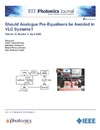Identificador persistente para citar o vincular este elemento:
https://accedacris.ulpgc.es/jspui/handle/10553/71249
| Campo DC | Valor | idioma |
|---|---|---|
| dc.contributor.author | Li, Xicong | en_US |
| dc.contributor.author | Ghassemlooy, Zabih | en_US |
| dc.contributor.author | Zvanovec, Stanislav | en_US |
| dc.contributor.author | Perez-Jimenez, Rafael | en_US |
| dc.contributor.author | Haigh, Paul Anthony | en_US |
| dc.date.accessioned | 2020-04-11T05:12:51Z | - |
| dc.date.available | 2020-04-11T05:12:51Z | - |
| dc.date.issued | 2020 | en_US |
| dc.identifier.issn | 1943-0655 | en_US |
| dc.identifier.other | Scopus | - |
| dc.identifier.uri | https://accedacris.ulpgc.es/handle/10553/71249 | - |
| dc.description.abstract | Visible light communication (VLC) systems are highly constrained by the limited 3-dB bandwidth of light-emitting diodes (LEDs). Analogue pre-equalisers have been proposed to extend the LED's bandwidth at the cost of reduced signal-to-noise ratio (SNR). Compared with the pre-equaliser, the multi-carrier modulation with bit-loading can efficiently use the spectrum beyond the LED's raw 3-dB bandwidth without incuring SNR penalties by employing multiple narrow quasi-flat sub-bands to eliminate the need for equalisation. In this work we show by means of theoretical and experimental investigation that VLC with multi-band carrierless amplitude and phase modulation with bit-loading can outperform VLC with analogue pre-equalisers. | en_US |
| dc.language | eng | en_US |
| dc.relation.ispartof | IEEE Photonics Journal | en_US |
| dc.source | IEEE Photonics Journal [ISSN 1943-0655], v. 12 (2), p. 1-14 | en_US |
| dc.subject | 3325 Tecnología de las telecomunicaciones | en_US |
| dc.subject.other | Cap. | en_US |
| dc.subject.other | Channel Capacity | en_US |
| dc.subject.other | Equaliser | en_US |
| dc.subject.other | Visible Light Communications (Vlc) | en_US |
| dc.title | Should analogue pre-equalisers be avoided in VLC systems? | en_US |
| dc.type | info:eu-repo/semantics/Article | en_US |
| dc.type | Article | en_US |
| dc.identifier.doi | 10.1109/JPHOT.2020.2966875 | en_US |
| dc.identifier.scopus | 85082659324 | - |
| dc.contributor.authorscopusid | 57211342846 | - |
| dc.contributor.authorscopusid | 7004547192 | - |
| dc.contributor.authorscopusid | 8346275300 | - |
| dc.contributor.authorscopusid | 56044417600 | - |
| dc.contributor.authorscopusid | 55103012600 | - |
| dc.identifier.issue | 2 | - |
| dc.relation.volume | 12 | en_US |
| dc.investigacion | Ingeniería y Arquitectura | en_US |
| dc.type2 | Artículo | en_US |
| dc.utils.revision | Sí | en_US |
| dc.identifier.ulpgc | Sí | es |
| dc.description.sjr | 0,725 | |
| dc.description.jcr | 2,443 | |
| dc.description.sjrq | Q1 | |
| dc.description.jcrq | Q2 | |
| dc.description.scie | SCIE | |
| item.fulltext | Con texto completo | - |
| item.grantfulltext | open | - |
| crisitem.author.dept | GIR IDeTIC: División de Fotónica y Comunicaciones | - |
| crisitem.author.dept | IU para el Desarrollo Tecnológico y la Innovación | - |
| crisitem.author.dept | Departamento de Señales y Comunicaciones | - |
| crisitem.author.orcid | 0000-0002-8849-592X | - |
| crisitem.author.parentorg | IU para el Desarrollo Tecnológico y la Innovación | - |
| crisitem.author.fullName | Pérez Jiménez, Rafael | - |
| Colección: | Artículos | |
Citas SCOPUSTM
15
actualizado el 08-jun-2025
Citas de WEB OF SCIENCETM
Citations
12
actualizado el 08-jun-2025
Visitas
139
actualizado el 31-may-2025
Descargas
189
actualizado el 31-may-2025
Google ScholarTM
Verifica
Altmetric
Comparte
Exporta metadatos
Los elementos en ULPGC accedaCRIS están protegidos por derechos de autor con todos los derechos reservados, a menos que se indique lo contrario.
